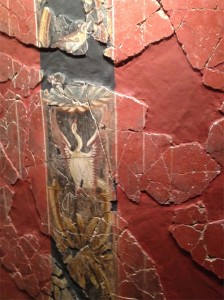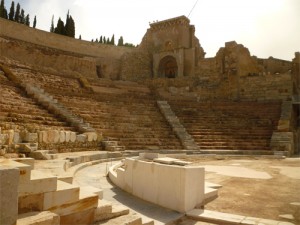The city of Cartagena has seen a number of ancient empires come and go in its two thousand year history. Romans, Phoenicians, Moors and Byzantines, to name but a few, have all controlled Cartagena at some point.
The port of Cartagena was of great strategic importance and therefore highly desirable to military powers. The deep-water port could comfortably harbour ships and was easily defended from the headlands that jut out into the sea, forcing any invading fleets into a bottleneck.
Some of the remains of these great empires can still be seen today at a number of archaeological sites across the city. Built by the Carthaginians in the 3rd century BC, the Punic Wall is the earliest construction on show. Located in a naturally defensive position between five hills, the wall marks the former city boundaries. Today, the remains of the wall are conserved as part of the Centre of Interpretation of the Punic Wall. Inside, the wall extends for thirty metres and is up to three metres high in some sections. The centre also houses a crypt dating back to the 16th century. Visitors can descend into the crypt where original paintings depicting the death dance, and skeletons still housed in stone chambers can be seen.
It was under Roman rule that the city first flourished and the majority of the city’s ancient ruins are Roman. Excavation in 2008 and 2009 on the Molinete Hill uncovered The District of the Roman Forum. Two buildings were uncovered: a spa complex and a banquet hall. Mosaic floors and painted walls are still visible, and a raised walkway above the two buildings allows visitors an overhead view of the bath’s under-floor heating system.
The House of Fortune is where you will find some of the city’s best preserved Roman decoration. Uncovered in 2000, this was formerly home to a wealthy family. The house offers a view into Roman life, with distinctly different rooms to be seen. The walls are intricately decorated and the colours still bold after over two millennia.
Perhaps the greatest and most surprising archaeological discovery of Roman ruins was that of the Theatre of Cartagena. The theatre is, again, a relatively recent unearthing. First discovered in 1988, it had been partially built over by the Old Cathedral. Carved into the hillside, the theatre had a capacity of 6,000 people. Sections of the stage have been reconstructed and really show the impressive scale of this ancient construction. Climb to the top seating tier and you’ll be rewarded with the contrasting views of Roman Cartagena and life in modern Cartagena happening just beyond the stage.
The best way to see these and all of the cultural sites in Cartagena is by purchasing a Cartagena Card from the Centre of Interpretation of the Punic Wall. It is like a menu of options from which you choose the sites and transport that appeal. For a package of 8 sites, including travel on the tourist bus and boat, the cost is around 22 Euros: the card is valid for two weeks. For more information on Cartagena, see here.
Cartagena is around a 90 minute drive from Alicante Airport and Drivalia Car Rental.
 Sweden
Sweden



